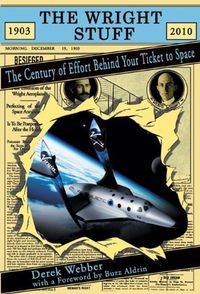Review: The Wright Stuffby Jeff Foust
|
| The book’s title, besides being a play on words of the “Right Stuff”, is also used by Webber to define a set of characteristics that “enables everyman to progress to a future in space.” |
There is a temptation to look at the progress that led to the current state of commercial space development in a linear fashion: a series of milestones from the earliest rockets to today’s SpaceShipTwo and its ilk in a methodical, logical manner. Of course, that’s not how development works in aerospace or any other field: progress comes in fits and starts, with its share of false starts and dead ends, for reasons of technology, finance, and policy. There is also an interconnected, multidimensional element that can’t be portrayed by a simple linear progression, as people can influence (and be influenced by) multiple individuals and events. That message is at the heart of a new book about the development of space tourism, The Wright Stuff.
As the title suggests, author Derek Webber begins his survey with the Wright Brothers over a century ago. (Full disclosure: Webber is a friend and former colleague of mine, and his book uses, with permission, several photos originally published here.) That may seem like going too far back—after all, the Wright Brothers weren’t thinking about space tourism when they invented the airplane—but it does lay the foundation for the century of developments that follow, and allows Webber to establish the linkages and interconnections at the heart of the book. The work of the Wrights and other early aviation pioneers, for example, enabled Charles Lindbergh to make his solo non-stop flight across the Atlantic; Lindbergh, later, would help sponsor rocket research by Robert Goddard and, after World War II, meet with Wernher von Braun. Lindbergh’s flight, meanwhile, won the Orteig Prize, which decades later would serve as the model for the Ansari X PRIZE won by Burt Rutan, who had been inspired as a student in part by meeting, at an AIAA awards ceremony, von Braun.
The book’s title, besides being a play on words of the “Right Stuff”, is also used by Webber to define a set of characteristics that “enables everyman to progress to a future in space.” Those factors, he writes, include vision, scientific and engineering knowledge, and marketing and financial know-how. In addition, he notes, there has to be the ability to actually use that knowledge to follow through on one’s vision: “Our motto is: ‘Look before you leap, but then you must leap!’ It’s no good if you forget the ‘leap’ part.” Webber goes as far as to bestow “Wright Stuff Awards” to those in the book who he believes best embody those characteristics. Some of the recipients are obvious: Lindbergh, von Braun, Rutan, as well as Richard Branson for creating Virgin Galactic and Buzz Aldrin (who also wrote the foreword of the book) for promoting space tourism. Some are less obvious, and perhaps more questionable, such as former president George W. Bush, who is honored primarily for signing into law the Commercial Space Launch Amendments Act of 2004, which helped establish a regulatory regime in the US that permits the development of suborbital space tourism. Bush, though, did little (overtly, at least) to support the legislation besides signing it once it passed Congress, and his other major contribution to space policy, the Vision for Space Exploration, has not survived the change in administrations.
The Wright Stuff, unlike some other books on space tourism, doesn’t try to sell a particular future for space tourism beyond the author’s belief that a new and vast market for commercial human spaceflight is opening up. The book is, instead, something of a dramatis personae of the field, identifying those key individuals who have contributed, directly or indirectly, to its development, and the interconnections among those people. While that new era might not be opening as quickly as its backers might have hoped or expected six years ago, this book illustrates how space tourism has roots stretching back over a century and, thus, is not something that will easily fade away.
